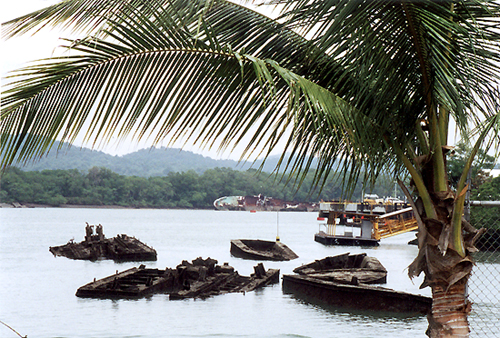![]()
| After the French failure to
complete the Panama Canal, there was tons of equipment rotting away in
swamps, shorelines, rivers, jungle and along the old rail lines. When the
French gave up, this equipment lay in position for many years until the
United States took over the project. Much of this equipment was
salvageable enough to put it back on in service...Belgium Locomotives,
dump/dirt cars, other rolling stock, hand operated dirt dump cars, large
excavators and ladder dredges. The Isthmian Canal Commission
rebuilt some of this equipment and entered it in the "Catalogue of
Equipment", purchased for use by the Isthmian Canal Commission
between July 1, 1904 - January 1, 1913.
This story is about two Belgium Ladder Dredges named "Badger" and "Marmot". Both found, rebuilt and used on the Pacific side diggings. They were made of an iron hull, non-propelling with the dimensions of 112"2" length; beam 29' 6"; draft, 9'. They had a fuel-oil capacity of 597.2 barrels. 2 main engines vertical tandem compound, 12 1/2", 25 1/2", 14 1/2" stroke - French make. 3 boilers, Scotch marine, 96" diameter, 103" length; 180-horsepower. Equipped with American-made air pumps, circulating pump, boiler-feed pump, bilge pump, and fresh-water pump. Ladder equipped with 32 buckets of 15 cubic feet capacity, capable of digging to the depth of 45'. Equipped with a galley and mess room and quarters for 8 officers and crew on upper deck. Equipped with dynamo and wired throughout for electric light. According to the "Catalogue
of Equipment", two Ladder Dredges built in Belgium in 1884 -1886
were rebuilt by the Balboa Shipways (Shops). The cost of
rebuilding and appraised value of hull and machinery, $35,000 -
$58,624.50 each. There are four Belgium Ladder Dredges shown in
the "Catalogue of Equipment" that were rebuilt. Numbers
1 and 5 on the Atlantic project and on
the Pacific side of the Isthmus, the "Badger" and
"Marmot". The two others were rebuilt at the Atlantic
Dry Docks. |
 |
After seeing this photo, I started digging for info. This is the best part of loving the history of our great home. Everywhere you turn, there is a story to be told. I did some research and found the specifics mentioned above. Then, I looked for some photos of these grand old ladder dredges. Here are a few showing the glory days of the ladder dredge to the dismantling and then to the point of what you see above in today's photo. |